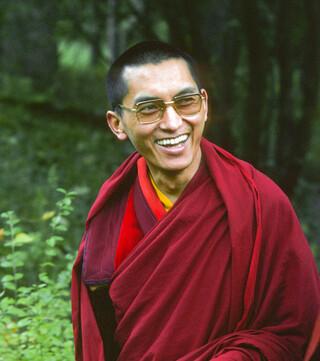Dear Friends,
Thanks for your interest in the Lama Yeshe Wisdom Archive and for subscribing to our monthly eletters. Feel free to share it with others!
And a heartfelt thank you to everyone who contributed to LYWA over Saka Dawa. Your support is greatly appreciated. Without you we wouldn't be able to do what we do!
In case you missed it, we are sharing this detailed and moving account from Kopan Monastery on the 49th day of Lama Zopa Rinpoche showing the aspect of passing away.
We are also happy to share this message of gratitude from the FPMT Board of Directors to Kopan Monastery and the entire FPMT organization for the extraordinary efforts that were made from the moment that Kyabje Zopa Rinpoche manifested the appearance of passing away.
From the Video Archive: Ösel at Sera Monastery circa 1994
This month from the video archive, we bring you a day in the life of young Tenzin Ösel Hita at Sera Monastery in South India in 1994. Along the way Ösel gives a short inspiring teaching and Lama Zopa Rinpoche makes an appearance filled with peals of laughter. Photographed and narrated by Ven. Roger Kunsang.
Visit and subscribe to the LYWA YouTube channel to view more videos freely available from our archive. See also the FPMT YouTube channel for many more videos of Lama Zopa Rinpoche’s teachings.
On the LYWA Podcast: Renouncing the Self-cherishing Thought
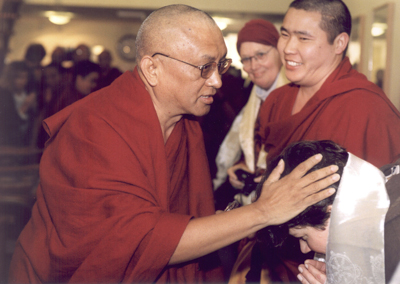 One must understand that by hurting others, you are also creating the cause to be hurt by others. To really solve the problem, one has to do something with the cause, which is within your mind.
One must understand that by hurting others, you are also creating the cause to be hurt by others. To really solve the problem, one has to do something with the cause, which is within your mind.
– Lama Zopa Rinpoche
This month on the LYWA podcast, Lama Zopa Rinpoche explains how the self-cherishing thought seeking happiness negatively affects our karma. But the study of karma is missing in Western psychology. So we must take special care to understand how karma works so we will be inspired to practice the methods that will stop and purify our negative karma. These teaching were given during a lamrim course hosted by Maitreya Instituut, Emst, in August, 1990. Follow along with the transcript on our website.
The LYWA podcast contains hundreds of hours of audio, each with links to the accompanying lightly edited transcripts. See the LYWA podcast page to search or browse the entire collection by topic or date, and for easy instructions on how to subscribe.
WHAT'S NEW ON OUR WEBSITE
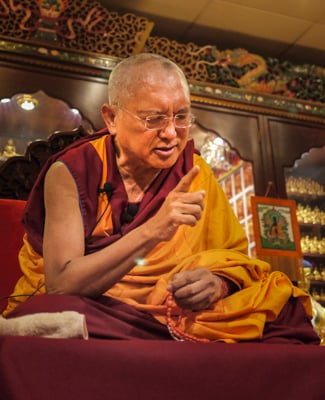 This month we have posted the 32nd Kopan Course, lamrim teachings given by Lama Zopa Rinpoche at Kopan Monastery, Nepal, in 1999. In these teachings Rinpoche gives detailed commentary on several prayers and practices, including the Requesting Prayer to the Lamrim Lineage Gurus, the Thirty-Five Buddhas practice and the Refuge and Bodhicitta prayer.
This month we have posted the 32nd Kopan Course, lamrim teachings given by Lama Zopa Rinpoche at Kopan Monastery, Nepal, in 1999. In these teachings Rinpoche gives detailed commentary on several prayers and practices, including the Requesting Prayer to the Lamrim Lineage Gurus, the Thirty-Five Buddhas practice and the Refuge and Bodhicitta prayer.
In Lecture Three, Rinpoche discusses each of the Thirty-five Buddha’s names in turn and outlines the eons of negative karma purified by reciting each buddha’s name. In Lecture 10, Rinpoche discusses the power of holy objects, and in Lecture 11, Rinpoche explains how to do prostrations, beginning with an altruistic motivation.
You can read these teachings online or download a PDF of the entire course. You can also read an excerpt from Lecture 4 in our monthly teaching below.
Every month we share new advices for Lama Zopa Rinpoche’s Online Advice Book, adding more than 100 new entries every year on a variety of topics. More precious than ever, there are now more than 2,200 of Rinpoche’s advices online. Here are a few more:
- Vajrayogini Pure Land: A student asked Rinpoche to check which tantric pure land would be most suitable for them and how they should prepare to go there.
- Structure for Long Lamrim Retreat: Rinpoche gave this advice to a long-time student who was going to do a long retreat.
- Confession of Negative Actions: A student wrote to Rinpoche confessing all their negative actions and asking what they could do to purify the karma. Rinpoche told the story of Milarepa, who purified all his past negative karma and became enlightened in one lifetime.
- Pleasing the Guru: Rinpoche wrote this letter to a monk who was helping at a Dharma center. Rinpoche had heard a lot of praise for how hard he was working.
You can always find a list of all the newly posted advices from Lama Zopa Rinpoche on our website.
FREE NEW AUDIOBOOK
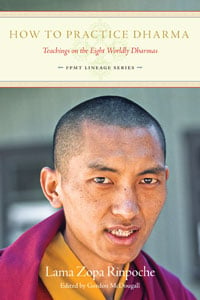 We are also happy to share with you a new free audiobook, How to Practice Dharma: Teachings on the Eight Worldly Dharmas by Lama Zopa Rinpoche. This book deals with the eight worldly dharmas, essentially how desire and attachment cause us to create problems and suffering and how to abandon these negative minds in order to find perfect peace and happiness.
We are also happy to share with you a new free audiobook, How to Practice Dharma: Teachings on the Eight Worldly Dharmas by Lama Zopa Rinpoche. This book deals with the eight worldly dharmas, essentially how desire and attachment cause us to create problems and suffering and how to abandon these negative minds in order to find perfect peace and happiness.
To access more free audiobooks visit the LYWA audiobook catalog, which includes some of our most popular books by Lama Yeshe and Lama Zopa Rinpoche, now available as free audiobooks from Google Play and titles for purchase from Audible. You can also find popular titles here on the LYWA YouTube channel.
We are also happy to share that FPMT recently published two compositions by Lama Zopa Rinpoche: How This Human Life Becomes the Method for Achieving Complete Buddhahood through Study and Service and An Abbreviated Chakrasamvara Tsog. You can find more information here on the FPMT website.
Thank you so much, and please read on for this month's teaching by Lama Zopa Rinpoche on the importance of the lamrim.
Big love,

Nick Ribush
Director
THIS MONTH'S TEACHING: The Lamrim Shows the Entire Path
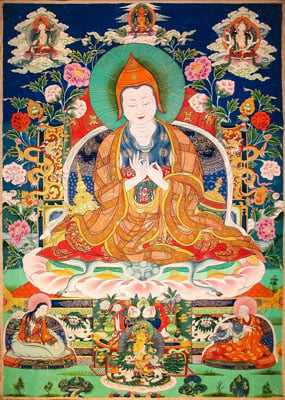 Lama Atisha wrote this special text, Lamp for the Path to Enlightenment. He integrated the Buddha’s Hinayana teachings, the Buddha’s Mahayana sutra teaching, everything was integrated as a graduated practice for one person to achieve enlightenment.
Lama Atisha wrote this special text, Lamp for the Path to Enlightenment. He integrated the Buddha’s Hinayana teachings, the Buddha’s Mahayana sutra teaching, everything was integrated as a graduated practice for one person to achieve enlightenment.
He made it very simple, like a meal, a lunch, already made and set up in a dish on the table, so that anybody can practice without any confusion. All these teachings from the Buddha—all the Hinayana teachings, the Mahayana sutra teachings and the Mahayana tantra teachings—can be practiced without any confusion. He made it very clear, setting all these teachings up as a gradual practice for one person to achieve enlightenment.
This is what is called lamrim, the steps on the path to enlightenment. The title “lamrim” started with Lama Atisha, after Lama Atisha had written this text. Before that, the meaning existed in a very vast way, in all these hundreds of volumes of the Buddha’s teachings and the commentaries by pandits and so forth. In the lamrim everything is there.
Studying and understanding the lamrim makes it very easy. Then we know what makes life most meaningful, and what is the most important thing to do to benefit other sentient beings and how to do that.
We come to know how to go about enlightenment by having an understanding of the lamrim, which is the integration of the whole of the Buddha’s teachings. We know where to begin. Having studied and understood the lamrim, whether we practice or not, at least we have a correct understanding of where to begin the path in order to achieve enlightenment and how to go about it. That’s an unbelievable protection.
Otherwise, we spend our life just in one meditation, like watching the breath, and then one day our life is gone, finished, with nothing developed. Nothing has happened inside. We’ve done nothing to reduce samsara; nothing has become a remedy to samsara. It’s even difficult to protect ourselves from the lower realms.
If all these meditations are done with the attachment clinging to this life, they all become nonvirtue, whether it’s watching the mind or the breath or walking meditation, paying attention as we are walking. They all become negative karma, nonvirtue, if they are done with attachment. They might be done with attachment for reputation, so that we can become a great master and teach meditation or something, reputation for the happiness of this life, to achieve some power, some mental comfort. Done with the attachment clinging to this life, all those actions of meditation become nonvirtue; nothing becomes special. It does not even become virtuous, it becomes the cause of lower realms, so it is difficult to even protect ourselves from the suffering of the lower realms with these meditations.
And especially when we meditate, if the motivation is never emphasized, if the motivation isn’t explained by a teacher, if we don’t know how to generate the motivation to meditate, that means we don’t know how to meditate. How to meditate doesn’t just mean breathing with the mouth, breathing in this way or breathing out that way. In and out is always there!
These instructions are not the real ones on how to meditate. How to meditate means knowing how to set our motivation before we meditate. That is the real way to meditate. Then, the next one is the technique itself, whatever the visualization is, how to concentrate, to focus on an object.
This teaching is excerpted from Kopan Course 32, held at Kopan Monastery, Nepal in November-December 1999. Lightly edited by Gordon McDougall. You can find the entire teaching here on our website.























